Related Research Articles
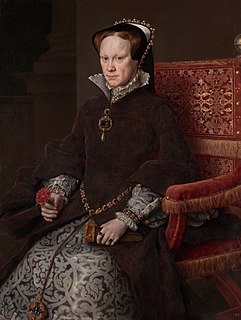
Mary I, also known as Mary Tudor, and as "Bloody Mary" by her Protestant opponents, was Queen of England and Ireland from July 1553 until her death in 1558. She is best known for her vigorous attempt to reverse the English Reformation, which had begun during the reign of her father, Henry VIII. Her attempt to restore to the Church the property confiscated in the previous two reigns was largely thwarted by Parliament, but during her five-year reign, Mary had over 280 religious dissenters burned at the stake in the Marian persecutions.

The House of Tudor was an English royal house of Welsh origin, descended from the Tudors of Penmynydd. Tudor monarchs ruled the Kingdom of England and its realms, including their ancestral Wales and the Lordship of Ireland from 1485 until 1603, with five monarchs in that period: Henry VII, Henry VIII, Edward VI, Mary I and Elizabeth I. The Tudors succeeded the House of Plantagenet as rulers of the Kingdom of England, and were succeeded by the House of Stuart. The first Tudor monarch, Henry VII of England, descended through his mother from a legitimised branch of the English royal House of Lancaster, a cadet house of the Plantagenets. The Tudor family rose to power in the wake of the Wars of the Roses (1455–1487), which left the Tudor-aligned House of Lancaster extinct in the male line.

Mary Tudor was an English princess who was briefly queen of France. She was the younger surviving daughter of King Henry VII of England and Elizabeth of York, and the third wife of Louis XII of France, who was more than 30 years older than her. Following his death, she married Charles Brandon, 1st Duke of Suffolk. Performed secretly in France, the marriage occurred without the consent of Mary's brother, Henry VIII. The marriage necessitated the intervention of Thomas Wolsey; Henry eventually pardoned the couple, after they paid a large fine.
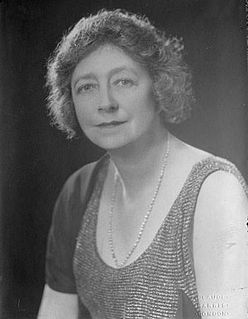
Dame Mary Louise Webster,, known professionally as May Whitty and later, for her charity work, Dame May Whitty, was an English stage and film actress. She was one of the first two women entertainers to become a Dame. The British actors' union Equity was established in her home. After a successful career she moved over to Hollywood films at the age of 72. She went to live in America, where she won awards for her film roles.

The Tudor period occurred between 1485 and 1603 in England and Wales and includes the Elizabethan period during the reign of Elizabeth I until 1603. The Tudor period coincides with the dynasty of the House of Tudor in England whose first monarch was Henry VII. Historian John Guy (1988) argued that "England was economically healthier, more expansive, and more optimistic under the Tudors" than at any time since the Roman occupation.

Una O'Connor was an Irish-American actress who worked extensively in theatre before becoming a character actress in film and in television. She often portrayed comical wives, housekeepers and servants. In 2020, she was listed at number 19 on The Irish Times list of Ireland's greatest film actors.
Mary Tudor may refer to:

Antony Tudor was an English ballet choreographer, teacher and dancer.
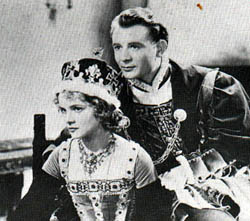
Tudor Rose is a 1936 British film directed by Robert Stevenson and starring Cedric Hardwicke and Nova Pilbeam.

The French hood is a type of woman's headgear that was popular in Western Europe in the 16th century.
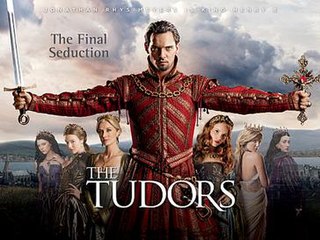
The Tudors is a historical fiction television series set primarily in 16th-century England, created and written by Michael Hirst and produced for the American premium cable television channel Showtime. The series was a collaboration among American, British, and Canadian producers, and was filmed mostly in Ireland. It is named after the Tudor dynasty as a whole, although it is based specifically upon the reign of King Henry VIII.

The Royal Family Order of Elizabeth II is an honour bestowed on female members of the British royal family by Queen Elizabeth II. The order is worn on formal occasions.
Linda Porter is an historian and British novelist.

The Armada Portrait of Elizabeth I of England is the name of any of three surviving versions of an allegorical panel painting depicting the Tudor queen surrounded by symbols of royal majesty against a backdrop representing the defeat of the Spanish Armada in 1588.
Owen Tudor (1938–1966) was a British Thoroughbred racehorse and sire. In a career that lasted from 1940 to 1942 he ran twelve times and won six races. His most important win came as a three-year-old in the summer of 1941 when he won the “New Derby” at Newmarket. During the Second World War many British racecourses were closed either for safety reasons or because the land was needed for military use. Epsom Downs Racecourse was used throughout the war for an anti-aircraft battery, leading to the creation of a substitute or “New” version of the race. Owen Tudor went on to win a substitute “Ascot Gold Cup” at Newmarket in 1942. At the end of that season he was retired to stud where he had considerable success as a sire of winners.
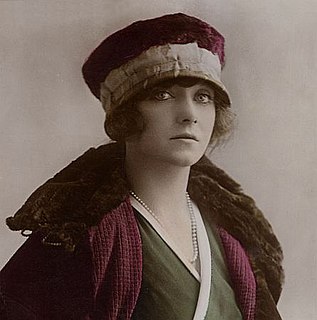
Winifred "Betty" Barnes was an English actress and singer known for roles in Edwardian musical comedy and operetta, creating the title role in Betty, among others. After 15 years on the stage, she retired upon her marriage in 1924.
The Mouthpiece is a 1930 crime play by the British writer Edgar Wallace. It was one of several theatrical failures written by Wallace following the enormous success of On the Spot, with a plot described as "flimsy".
Smoky Cell is a thriller play by the British writer Edgar Wallace first staged in 1930. In America a group of detectives hunt down a notorious racketeer.
Norman Ginsbury (1902–1991) was a British writer, known for his plays. He also wrote material for film and television.
Mary Hinton (1896–1979) was a British stage, film and television actress. She was born as Emily Rachel Forster, the daughter of the politician Henry Forster, 1st Baron Forster, and became a regular British character actor for several decades. In the West End she appeared in Wilfrid Grantham's Mary Tudor (1935), Rose Franken's Claudia (1942) and Lesley Storm's Great Day (1945).
References
- ↑ Wearing p.487